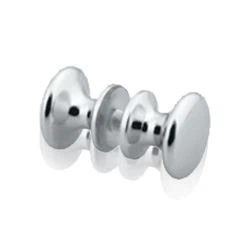Hey there! As a supplier of machining parts, I've seen firsthand how crucial grinding machines are in the manufacturing process. In this blog, I'll break down the functions of a grinding machine in machining parts and why it's a game - changer in our industry.
Surface Finishing
One of the most important functions of a grinding machine is surface finishing. When we produce parts, the initial manufacturing process might leave the surface rough. Whether it's through casting, forging, or other machining methods, the raw surface isn't always up to the standards required for the final product.
A grinding machine uses an abrasive wheel to remove tiny amounts of material from the surface of the part. This process smooths out any bumps, ridges, or irregularities left behind. For example, in Titanium Parts, a smooth surface finish is not only aesthetically pleasing but also crucial for its performance. A rough surface can lead to increased friction, which might cause premature wear and tear, or even affect the part's functionality in a mechanical system.
Size and Dimensional Accuracy
Getting the right size and dimensions for a part is non - negotiable. A grinding machine plays a key role in achieving this. It can precisely remove material to bring the part to the exact specifications.
Let's say we're making Hot Forging Machining Parts. After the forging process, the part might be slightly larger than the required size. The grinding machine can be set to remove a specific amount of material, ensuring that the length, width, and height of the part are within the tight tolerances specified by the customer. This is especially important in industries like aerospace and automotive, where even the slightest deviation from the required dimensions can lead to serious safety issues.
Shape Correction
Sometimes, parts don't come out in the exact shape we want during the initial manufacturing. A grinding machine can correct these shape irregularities.
For instance, if a cylindrical part has a slight taper or is out - of - round, the grinding machine can be used to reshape it. By carefully controlling the movement of the abrasive wheel, we can grind the part to the correct circular shape or eliminate any tapering. This is essential for parts that need to fit precisely into other components, such as bearings or shafts.
Material Removal for Complex Geometries
In modern manufacturing, parts often have complex geometries. Grinding machines are capable of removing material from these intricate shapes.
Take Restaurant Equipment Parts as an example. Some of these parts might have curved surfaces, slots, or holes with specific angles. A grinding machine can access these hard - to - reach areas and remove material accurately. This allows us to create parts that are not only functional but also fit seamlessly into the overall equipment design.
Deburring
After other machining operations like cutting or drilling, parts often have burrs. Burrs are small, sharp edges or protrusions of material that can be a safety hazard and also affect the part's performance.
A grinding machine can quickly and effectively remove these burrs. By using a fine - grit abrasive wheel, we can gently smooth out the edges of the part, eliminating any sharp points. This is important for parts that will be handled by workers or that need to be assembled with other components, as burrs can interfere with the assembly process.
Heat Treatment and Stress Relief
Grinding can also be used in combination with heat treatment processes. After heat - treating a part, there can be residual stresses within the material. These stresses can cause the part to warp or crack over time.
A controlled grinding process can help relieve these stresses. By removing a small amount of material in a specific way, we can balance the internal stresses in the part. This is especially important for high - performance parts that are subjected to extreme conditions, such as in the energy or defense industries.
Preparing for Coating or Plating
Before applying a coating or plating to a part, it's essential to have a clean and smooth surface. A grinding machine can prepare the surface of the part for these processes.
By removing any surface contaminants and creating a smooth finish, the coating or plating can adhere better to the part. This improves the durability and performance of the coating, which is important for parts that need to resist corrosion, wear, or other environmental factors.
Final Inspection and Quality Assurance
Grinding is often the last step in the machining process, and it serves as a final check for quality. After grinding, we can closely inspect the part to ensure that it meets all the required specifications.
We can use precision measuring tools to verify the size, shape, and surface finish of the part. If there are any minor issues, we can make final adjustments using the grinding machine. This helps us to guarantee that only high - quality parts are delivered to our customers.
Conclusion
As you can see, the functions of a grinding machine in machining parts are diverse and crucial. From achieving the perfect surface finish to ensuring dimensional accuracy, shape correction, and more, it's an indispensable tool in our manufacturing process.
Whether you're in the market for Titanium Parts, Hot Forging Machining Parts, or Restaurant Equipment Parts, our expertise in using grinding machines ensures that you'll get parts of the highest quality.
If you're interested in our machining parts and want to discuss your specific requirements, feel free to reach out. We're always eager to start a conversation and work with you to meet your needs.


References
- Kalpakjian, S., & Schmid, S. R. (2009). Manufacturing Engineering and Technology. Pearson Prentice Hall.
- Groover, M. P. (2010). Fundamentals of Modern Manufacturing: Materials, Processes, and Systems. Wiley.



